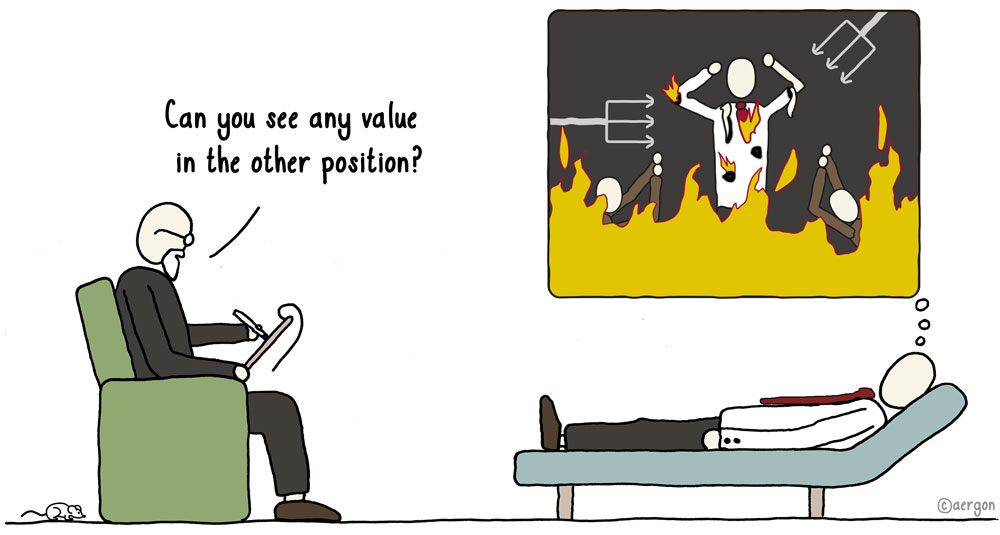
Transformation Perspectives Series 09
In our quest for sustainable success, how can we resolve this organizational paradox: the need for continuity versus the need for digital transformation?
In previous issues of Transformation Perspectives we discussed the meaning of purpose and values, and what they contribute. Following on from that idea, in this article we will illustrate how to resolve apparently incompatible positions.
Life seems to be full of paradoxes, of apparently contradictory needs. On one hand, we want to be safe. On the other, we want variety and adventure. We strive for professional success, and yet we also want a fulfilled family life. As leaders we want to be self-assured, yet also humble. And, as the title says, in business we encounter the need for continuity, and at the same time the apparently paradoxical need for digital transformation. How can we resolve these issues in order to achieve sustainable success?
To fully understand the apparent paradox of continuity vs. transformation, it is important to know the difference between problems (which can be solved) and dilemmas, or polarities (which are ongoing, and therefore can only be managed, not solved). Let’s take a look at the definitions:
- Problem: an issue that can have a right answer, or a best answer. Once you have found the best answer, the problem is resolved and you can move on.
- Dilemma / polarity: an issue that is ongoing, that does not have a definitive solution. Two seemingly contradictory positions need to be balanced – you can compare this metaphorically with breathing in and breathing out. As long as the system is operating there will be no end to either function, and therefore no definitive solution. Polarities simply need to be managed.
So if we consider the need for continuity vs. the need for digital transformation, is this a problem or a polarity? Quite clearly it is a polarity – an ongoing issue that has to be understood and managed.
The polarity that underlies this issue is the polarity of safety vs. change. One of our basic needs is to be safe, yet at the same time we also want variety. If we were granted absolute safety and security, i.e. if we knew exactly what was going to happen at all times and our safety was guaranteed, we would very soon get bored. On the other hand, endless variety with many changes occurring at the same time in all areas of our life would quickly overwhelm us. We respond to different situations with a certain unconscious bias that reflects our conditioned preferences resulting from our individual upbringing. If, for example, your upbringing offered you plenty of safety and trust and you were encouraged to explore new things, you might feel more inclined to venture out into the unknown. If, on the other hand, you experienced a lot of turmoil and not much safety during your formative years, you are likely to react more cautiously. Therefore, the polarity of safety vs. change need to be better understood. It is about finding a balance between the two poles.
This polarity between continuity and change can be seen more and more often in companies facing major digital change projects; in these scenarios there is usually a clear business logic, but all too often there is a lack of support and alignment reflected in the actions of the many employees who are affected. In most cases, those employees have preferences which we can map on a bipolar scale with “continuity” on one side and “change” on the other. In order to address and resolve this issue, in our work we find it helpful to shed light on the underlying values and limiting beliefs. “Continuity” is often associated with values such as stability, trust and safety, whereas “change” is often associated with opportunity, growth, creativity or necessary innovation. On the surface these are contradictory positions, and our choice of position and values is unconsciously supported by a set of limiting beliefs about the other polarity (c.f. Graph 1: Value and corresponding beliefs about the other value). People who are clear supporters of “continuity” and prefer to stick to tried and proven approaches often have unconscious beliefs concerning “change”, i.e. they believe it will create chaos, confusion and frustration, with
Graph 1: Polarities of “Continuity” and “Change” (based on Polarity Partnerships)

little gain at the end, and too high a risk overall. Promoters of “change”, on the other hand, often have unconscious beliefs concerning “continuity”, i.e. they believe it will lead to stagnation, loss of momentum and energy, and will eventually result in not being able to meet market demands.
The most important step towards resolving this issue is to understand that it is not a problem to be solved (i.e. there is no “best solution”), but rather it is a polarity, where both poles are important and need to co-exist. Creating awareness of the interdependency of the two poles then allows us to reframe the issue from the “either, or” position to a position that embraces both poles. Meaning that we need both continuity and change, and we need a nuanced understanding of the benefits of both positions in the context of a company’s purpose and strategy. By creating this understanding and aligning employees with the action plan moving forward, you will be much better able to harness their energies and coordinate their actions, resulting in a more successful change project.
Incidentally, this is what we call transformation: an insight that creates an irrevocable shift of perspective, allowing better choices and outcomes. As leaders we will be more effective if we can integrate and manage polarities, and as employees we will perform better if we are aware of the issues and if we are supported by systems and processes that help us to understand our perceived polarities and manage them well.
Dr. Mélanie Huser and Dr. Thomas Gartenmann
This is part of the Transformation Perspectives Series by www.aergon.com

